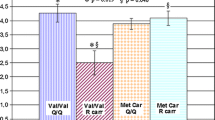Synaptosomal protein SNAP-25 is involved in the process of transmitting nerve spikes in the CNS and in the consolidation of memory traces in the hippocampus. Two independent studies have demonstrated associations between SNAP-25 gene polymorphisms and intellectual functions in a group of mentally healthy subjects and patients with schizophrenia. The aim of the present work was to perform a comparative study of the association between the MnlI polymorphism of SNAP-25 and cognitive functions (verbal memory, attention/executive functions) in 66 patients with endogenous psychoses, 75 of their mentally healthy relatives, and 136 healthy control subjects. Statistical analysis showed that the effectiveness of performing cognitive tests was significantly affected by group assignment (p = 0.00001) and genotype (p = 0.012). The interaction between genotype and group assignment also had an influence (p = 0.02). In all groups, carriers of the TT genotype had worse measures than carriers of other genotypes. The similar nature of the influences of the MnlI polymorphism on variations in measures in all groups indicates that this gene is related to overall intellect.
Similar content being viewed by others
References
M. V. Alfimova, “Mild cognitive disorders in relatives of schizophrenia patients,” Psikhiatriya, 4–6, No. 22–24, 75–84 (2006).
V. E. Golimbet, “Molecular genetic studies of cognitive impairments in schizophrenia,” Mol. Biol. (2008) (in press).
T. V. Lezheiko, The Role of a Molecular Genetic Polymorphism in the Manifestation of Cognitive Functions in Schizophrenia Patients and Mentally Healthy Subjects [in Russian], Author’s Abstract of Master’s Thesis in Medical Sciences, Moscow (2007).
R. Plomin and T. S. Prais, “Genetics and Cognitive Abilities,” Inostr. Psikhol., 14, 6–16 (2001).
W. J. Chen, S. K. Liu, C. J. Chang, et al., “Sustained attention deficit and schizotypal personality features in nonpsychotic relatives of schizophrenic patients,” Am. J. Psychiat., 155,. 1214–1220 (1998).
M. F. Gosso, E. J. de Geus, M. J. van Benzen, et al., “The SNAP-25 gene is associated with cognitive ability: evidence from a familybased study in two independent Dutch cohorts,” Mol. Psychiat., 11, No. 9, 878–886 (2006).
M. F. Gosso, E. J. de Geus, T. J. Polderman, et al., “Common variants underlying cognitive ability: further evidence for association between the SNAP-25 gene and cognition using a family-based study in two independent Dutch cohorts,” Genes Brain Behav., 7, No. 3, 355–364 (2008).
Q. Hou, X. Gao, X. Zhang, et al., “SNAP-25 in hippocampal CA1 region is involved in memory consolidation,” Eur. J. Neurosci., 20, No. 6, 1593–1603 (2004).
J. Hurt, C. R. Harrington, et al., “Loss of synaptic but not cytoskeletal proteins in the cerebellum of chronic schizophrenics,” Neurosci. Lett., 317, No. 3, 161–165 (2002).
E. Scarr, L. Gray, D. Keriakous, P. J. Robinson, et al., “Increased levels of SNAP-25 and synaptophysin in the dorsolateral prefrontal cortex in bipolar I disorder,” Bipolar Disorder, 8, No. 2, 133–143 (2006).
I. Spellman, N. Müller, et al., “Associations of SNAP-25 polymorphismswith cognitive dysfunctions in Caucasian patients with schizophrenia during a brief trial of treatment with atypical antipsychotics,” Eur. Arch. Psychiatr. Clin. Neurosci., (2008) (in press).
H. Tachikawa, S. Harada,Y. Kawanishi, et al., “Polymorphism of the 5’-upstream region of the human SNAP-25 gene: an association analysis with schizophrenia,” Neuropsychobiology, 43, No. 3, 131–133 (2001).
A. Thapar, M. O’Donovan, and M. J. Owen, “The genetics of attention deficit hyperactivity disorder,” Hum. Mol. Genet., 14, No. 2, 275–282 (2005).
P. M. Thompson, S. Egbufoama, and M. P. Vawter, “SNAP-25 reduction in the hippocampus of patients with schizophrenia,” Prog. Neuropsychopharmacol. Biol. Psychiat., 27, No. 3, 411–417 (2003).
A. Tuulio-Henriksson, J. Haukka, T. Partonen, et al., “Heritability and number of quantitative trait loci of neurocognitive functions in families with schizophrenia,” Am. J. Med. Genet., 114, 483–490 (2002).
A. H. Wong and H. H. Van Tol, “The dopamine D4 receptors and mechanisms of antipsychotic atypicality,” Prog. Neuropsychopharmacol. Biol. Psychiat., 27, No. 7, 1091–1099 (2003).
Author information
Authors and Affiliations
Additional information
Translated from Zhurnal Nevrologii i Psikhatrii imeni S. S. Korsakova, Vol. 109, No. 1, pp. 59–63, January, 2009.
Rights and permissions
About this article
Cite this article
Golimbet, V.E., Alfimova, M.V., Gritsenko, I.K. et al. Association between a Synaptosomal Protein (SNAP-25) Gene Polymorphism and Verbal Memory and Attention in Patients with Endogenous Psychoses and Mentally Healthy Subjects. Neurosci Behav Physi 40, 461–465 (2010). https://doi.org/10.1007/s11055-010-9280-x
Published:
Issue Date:
DOI: https://doi.org/10.1007/s11055-010-9280-x




